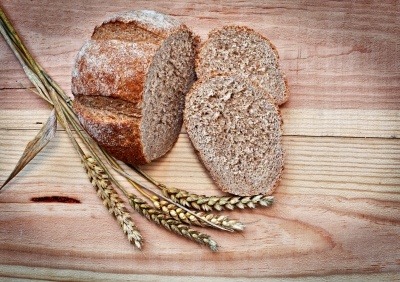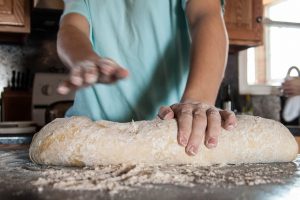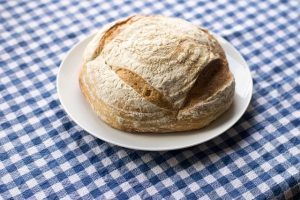
Bread is a staple food made by combining flour, water, yeast, salt, and sometimes sugar and fat. Of all the baked foods it is still the most popular. It is a versatile food that can be eaten as a main meal or as a side dish, and is enjoyed by people all over the world. Bread has widespread appeal because it is so nutritious with exceptional textural and sensorial properties. In this article, I will explain bread in detail, covering the main steps involved in making this delicious and nutritious food.
Ingredients
Flour
Wheat flour is the most commonly used flour in bread making, and is preferred for several reasons.
- Gluten formation: Wheat flour contains gluten (gliadin and glutenin), a protein that is essential for creating the structure and texture of bread. When wheat flour is mixed with water, gluten strands form and develop as the dough is kneaded, giving the bread its characteristic chewy texture.
- flavour: Wheat flour has a mild, nutty flavour that is well-suited to bread making. Additionally, the fermentation process used in bread making can create complex flavour compounds that add depth and richness to the bread.
- Versatility: Wheat flour can be used to make a wide variety of breads, from crusty artisan loaves to soft sandwich breads. It is also a versatile flour that can be combined with other flours, such as rye or cornmeal, to create unique flavours and textures.
- Availability: Wheat flour is widely available and affordable, making it accessible to home bakers and professional bakers alike.
While wheat flour is the most commonly used flour in bread making, it is not the only option. Other flours, such as rye, spelt, and barley, can also be used to make bread. However, these flours do not contain as much gluten as wheat flour, and may require different techniques to achieve the desired texture and structure in the finished bread.
The Need for Water in Bread Making
Water is a crucial ingredient in bread baking, and is necessary for several reasons:
- Hydration: Water is needed to hydrate the flour, which allows the gluten strands to develop. Gluten is a protein that forms when wheat flour is mixed with water, and is responsible for giving bread its structure and texture.
- Yeast activation: Yeast needs water to activate and begin the fermentation process. When yeast is combined with water, it feeds on the sugar in the dough and produces carbon dioxide gas, which causes the dough to rise.
- Temperature control: Water helps to control the temperature of the dough during mixing and fermentation. The temperature of the water can be adjusted to control the rate of fermentation, which can affect the flavour and texture of the bread.
- Moisture: Water provides moisture to the dough, which is necessary to create a tender crumb and prevent the bread from becoming dry and crumbly.
It is important to note that the amount and temperature of the water used in bread baking can have a significant impact on the final product. Too little water can result in a dense, dry loaf, while too much water can make the dough sticky and difficult to handle. Additionally, the temperature of the water can affect the rate of fermentation and the texture of the bread. Therefore, it is important to follow the recipe carefully and use water that is the correct temperature to achieve the desired results.
The Use of Salt
Salt is a crucial ingredient in bread making, and is needed for several reasons:
- flavour: Salt adds a savory flavour to bread that enhances the other ingredients and helps to balance the sweetness of sugar. It also helps to mask any unpleasant flavours that may be present in the dough, such as bitterness from over-fermentation.
- Gluten development: Salt plays a role in gluten development, helping to strengthen the gluten strands and create a more cohesive dough. This can improve the texture and structure of the bread.
- Fermentation control: Salt helps to control the rate of fermentation in the dough. Yeast produces carbon dioxide gas as it ferments, and salt slows down this process, preventing the dough from over-fermenting and becoming too sour.
- Preservation: Salt helps to preserve the bread by inhibiting the growth of microorganisms that can cause spoilage. This can help the bread to stay fresh for longer periods of time.
It is important to note that salt should be used in moderation in bread making. Too little salt can result in a bland-tasting bread, while too much salt can inhibit yeast fermentation and lead to a dense, heavy loaf. The amount of salt needed can vary depending on the recipe and personal taste preferences, but most bread recipes call for about 1-2% salt by weight of flour.
The Use Of Sugar
While sugar is not always necessary for bread making, it is often included in bread recipes for several reasons:
- flavour: Sugar adds a pleasant sweetness to bread that many people enjoy. This is particularly true for sweet breads, such as cinnamon raisin bread or brioche.
- Color: Sugar helps to brown the crust of the bread and give it a more attractive appearance.
- Texture: Sugar helps to tenderize the crumb of the bread, making it softer and more moist. This is particularly true in enriched breads, which contain additional fat and eggs that can make the bread tough if not balanced with sugar.
- Yeast food: Yeast feeds on sugar to produce carbon dioxide, which is necessary for the bread to rise. Including sugar in the dough provides yeast with a ready source of food, helping it to ferment and produce more gas.
It is important to note that while sugar can improve the flavour and texture of bread, it can also have negative effects if used in excess. Too much sugar can lead to an overly sweet bread, and can also interfere with yeast fermentation, resulting in a dense, heavy loaf. Therefore, it is important to follow the recipe carefully and use sugar in moderation to achieve the desired results.
Baker’s Yeast
Baker’s yeast is a type of fungus that is commonly used as a leavening agent in baking. It is a single-celled organism called Saccharomyces cerevisiae, which ferments sugars in dough to produce carbon dioxide gas as well as some ethanol. This gas gets trapped in the dough, causing it to rise and become light and fluffy during baking.
Baker’s yeast can be used to make a variety of baked goods, including bread, pizza dough, and pastries. It is available in various forms, including fresh, active dry, and instant yeast. A different strain is used in brewing and known as brewer’s yeast.
Fresh yeast, also known as compressed or cake yeast, is a soft, moist block of yeast that is sold in the refrigerated section of the grocery store. It must be used within a week or two of purchase and is most commonly used by professional bakers.
Active dry yeast is a granulated form of yeast that is sold in packets or jars. It has a longer shelf life than fresh yeast and is more commonly used by home bakers. To use active dry yeast, it must first be dissolved in warm water with a small amount of sugar before being added to the dough.
Instant yeast, also known as rapid-rise or quick-rise yeast, is a more finely ground form of active dry yeast. It can be added directly to the dough without being dissolved in water first and is often preferred by home bakers for its convenience and ease of use.
Baker’s yeast can also be used in combination with other leavening agents, such as baking powder and baking soda, to achieve the desired rise and texture in baked goods. It is important to follow the recipe instructions carefully when using yeast, as factors such as temperature and rising time can affect the outcome of the baked goods.
Overall, baker’s yeast is an important ingredient in baking that helps to create light and fluffy bread and other baked goods. It is available in various forms and can be used in combination with other leavening agents to achieve the desired results.
The Purpose of Leavening
Leavening is a crucial step in bread making, as it is responsible for creating the bread’s characteristic texture, flavour, and volume. The purpose of leavening in bread making is to create a light, airy crumb by causing the bread dough to rise. When the dough is leavened, it traps gas bubbles inside, which expand as the bread bakes, causing the bread to rise and become light and fluffy.
Traditionally, bread is leavened using yeast, which is a type of fungus that ferments the sugars in the dough, releasing carbon dioxide gas. The carbon dioxide gas gets trapped in the dough, causing it to expand and rise. As the yeast ferments the dough, it also produces alcohol and other flavour compounds that give bread its distinct aroma and taste.
In addition to yeast, bread can also be leavened using sourdough, which is a mixture of flour and water that has been fermented by wild yeast and bacteria. Sourdough provides a different flavour and texture to bread than yeast, and the fermentation process can take longer, resulting in a more complex flavour profile.
Other methods of leavening bread include using chemical leaveners or raising agents as they are also called. These include mostly baking powder or baking soda, which release carbon dioxide gas when combined with an acidic ingredient, such as buttermilk or vinegar. These methods are commonly used in quick breads, such as banana bread or cornbread, which do not require the long fermentation process of traditional yeast breads. Raising agents are also incorporated into self-raising flours which are convenient to use saving time and money in preparing both dough and reducing the complexity of dough preparation.
In this process the raising agent decomposes releasing carbon dioxide at around 30 to 40ºC along with water as steam when the temperature exceeds 100ºC (atmospheric baking).
In summary, the purpose of leavening in bread making is to create a light, airy texture and distinctive flavour by causing the bread dough to rise. This is typically accomplished through the use of yeast or sourdough, but can also be achieved through the use of baking powder or baking soda in quick breads. Understanding the role of leavening in bread making is essential for achieving the desired texture and flavour in the finished product.
Step 1: Mixing the dough
The first step in making bread is mixing the dough. This is done by combining flour, water, yeast, salt, and any other ingredients that are required. The dough can be mixed by hand or by using a bread machine, and it is important to ensure that all the ingredients are evenly distributed throughout the mixture.
Step 2: Kneading the dough
Once the dough has been mixed, it needs to be kneaded. Kneading helps to develop the gluten in the dough, which gives bread its characteristic texture and chewiness. This can be done by hand or using a bread machine, and it involves stretching and folding the dough repeatedly.
Step 3: Proofing the dough
After the dough has been kneaded, it needs to be left to proof. This involves allowing the dough to rest in a warm, humid environment so that the yeast can ferment and produce carbon dioxide, which causes the dough to rise. This process can take anywhere from a few hours to overnight, depending on the recipe.
Step 4: Shaping the dough
Once the dough has proofed, it needs to be shaped into the desired shape. This can be done by hand or using a bread machine, and it involves forming the dough into a loaf, rolls, or any other shape that is required. This step is important because it helps to create an even texture and shape in the finished product.

Step 5: Baking the bread
The final step in making bread is baking it. This involves placing the shaped dough into an oven and baking it at a high temperature for a set amount of time. This step is crucial because it ensures that the bread is fully cooked and has a crispy crust and soft, fluffy interior.
There are several different types of bread, each with its own unique recipe and manufacturing process. Here are some of the most common types of bread and how they are made:
- White bread
White bread is one of the most popular types of bread, and it is made by using flour that has been stripped of its bran and germ, resulting in a lighter and softer texture. To make white bread, the dough is mixed, kneaded, proofed, shaped, and then baked at a high temperature for around 30-40 minutes.
- Whole wheat bread
Whole wheat bread is made using whole wheat flour, which contains the bran and germ, resulting in a denser and nuttier texture. To make whole wheat bread, the dough is mixed, kneaded, proofed, shaped, and then baked at a slightly lower temperature for around 40-50 minutes.
- Sourdough bread
Sourdough bread is made using a natural yeast starter, which gives it a tangy and slightly sour flavour. To make sourdough bread, the starter is mixed with flour and water, and then left to ferment for several hours or overnight. The dough is then kneaded, proofed, shaped, and baked at a high temperature for around 45-60 minutes.

- Rye bread
Rye bread is made using rye flour, which has a lower gluten content than wheat flour, resulting in a denser and heavier texture. To make rye bread, the dough is mixed, kneaded, proofed, shaped, and then baked at a slightly lower temperature for around 50-60 minutes.
Bread Analysis
Texture
Dough is usually analysed for texture using a texture analyser. Before beginning analysis, the material to be tested is placed between moulding and compression plates, so that inside the press, samples with suitable size analysis are produced. After this stage, each sample is individually rested on a support table or structure, which is inside the material testing machine. The material testing machine starts in the tensile direction, and the tensile hook records the test load.
Crumb Texture
All bread loaves are uniformly sliced to a defined thickness with the loaf crust removed. Cylindrical crumb samples usually 28 mm diameter are cut from the centre of each bread loaf using a circular cutter. These are assessed using a texture analyser. The force required to compress slices of bread to a predetermined level of penetration against a rigid back plate using a cylindrical plunger was recorded for each sample tested.


Leave a Reply